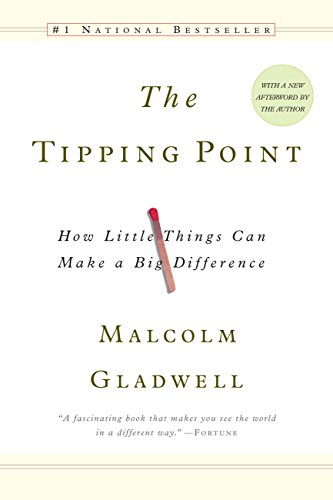

This article is an excerpt from the Shortform summary of "The Tipping Point" by Malcolm Gladwell. Shortform has the world's best summaries of books you should be reading.
Like this article? Sign up for a free trial here .
Are you looking to further your understanding of The Tipping Point? Do you understand all of the lessons from the book?
The Tipping Point by Malcolm Gladwell (the author of Outliers) focuses on how to push ideas or products to a tipping point in order to create a social epidemic. He that there are three factors that can be adjusted to tip an idea to a social epidemic: the messenger, the message itself, or the context of the message.
Below, we’ve put together some The Tipping Point discussion questions and a quiz, with answers.
The Tipping Point by Malcolm Gladwell
How do you spark a trend that spreads like wildfire, or turn a product into the latest must-have item? You create a social epidemic. The Tipping Point explains how social epidemics—spreading ideas, messages, behaviors, and products—function like viruses, growing gradually until they reach a critical mass (the tipping point) and explode.
Here are The Tipping Point discussion questions followed by a quiz.
Discussion 1: Enlisting Effective Messengers
To turn your product, message, or idea into an epidemic, you may need to enlist the help of skilled messengers (Connectors, Mavens, or Salesmen) to help you get the word out. Use this exercise to help you identify these people and determine how they can help tip your epidemic.
- Describe a product or idea you are trying to tip into an epidemic. (This can be the product your company is selling, the culture change you’re trying to create at your workplace, even an effort at home to get everyone to wash dishes as soon as they’re dirtied. )
- In this situation, who would be a Connector, a person (or group of people) who is well-known among the people you’re trying to influence?
- Who is a relevant Maven, who has trusted expertise in this subject area? Who is someone that people go to for the best advice?
- Who is a Salesman you can enlist, some kind of influencer who has natural persuasive power and gets people excited about their ideas?
Discussion 2: Crafting a Sticky Message
To create an epidemic, you have to be deliberate about how you present your idea and how people receive it. Use this exercise to help identify how you can make your idea sticky and create a context that makes people more open to it.
- Think of a product or idea you are trying to tip into an epidemic. Who is your targeted audience, or whose ideas and behaviors are you trying to influence?
- Think about how you have presented your idea so far and how effective your message has been. How might you be able to present your idea differently to make it more memorable and impactful?
- What is the context in which your audience is operating, and how is that influencing their current behavior? Consider the environmental and social context.
- What could you change about the environmental or social context of the situation to make people more likely to adopt the idea or behavior you’re trying to spread?
Quiz: The Ingredients of Social Epidemics
Whether you are an entrepreneur, activist, or advertising agency, it can be invaluable to understand the principles of creating a social epidemic. Here we’ll review the primary factors and players that help tip epidemics.
Question 1: The three rules of social epidemics discussed in the book are the Law of the Few, the Stickiness Factor, and the Power of Context. Explain how to maximize the three aspects of tipping an epidemic.
Answer Explanation
- Choosing the most effective messengers who spread the idea behind an epidemic. (Or simply, the messengers.)
- Presenting the idea to make it contagious, memorable, and impactful. (Or simply, the message.)
- Creating an environment that will make people more receptive to adopting your idea. (Or simply, the context or environment.)
Question 2: What makes Connectors so effective at helping to spread the message or idea in an epidemic?
- A. They are people in positions of power.
- B. They have many acquaintances in different communities. (correct)
- C. They are closely tied to the person who is trying to start the epidemic.
Answer Explanation
B is the correct answer because Connectors’ primary power is that they are well connected with many acquaintances (or weak ties) in lots of different communities (e.g. professional organizations, hobby groups, community and social groups, religious centers, etc), which gives them a broader reach in being able to spread a message to create an epidemic.
Question 3: What is Mavens’ strength in helping to tip an epidemic?
- A. They are information specialists who love to share their knowledge. (correct)
- B. They are innovators who come up with contagious ideas.
- C. They know a lot of people who are influencers.
Answer Explanation
A is correct because Mavens are information specialists, whereas Connectors are people specialists. Mavens have extensive knowledge about particular topics or markets, and they find as much pleasure in sharing the information with others as they do in collecting it. This makes them reliable sources of information, and the power of their recommendations can help tip an epidemic.
Question 4: What natural skill do Salesmen have that makes them so persuasive?
- A. They are relentless and won’t give up until they’ve convinced you to buy what they’re selling.
- B. Their natural aptitude for nonverbal communication helps them subconsciously instill trust. (correct)
- C. They know how to cleverly distract people from concerns and opposition.
Answer Explanation
B is correct because, aside from a natural charm and likability, Salesmen are adept at putting people at ease and influencing their emotions through nonverbal communication cues. Their ability to set the tone and affect people’s emotions in conversations is a very powerful persuasive tool.
Question 5: What does it mean for an idea or message to be “sticky”?
Answer Explanation
An idea is sticky if it is memorable enough to make a lasting impact and inspire an action or change in behavior. An idea, message, or product needs to be sticky in order to tip an epidemic because otherwise, if no one remembers it, they won’t change their behavior or buy the product.
Question 6: Give an example of how social context can affect people’s behavior.
Answer Explanation
One possible answer is that people behave differently depending on whether they are by themselves or with other people or, similarly, whether they are at home or in public. Another answer is that people act differently depending on who they’re with; their behavior is different when they’re at a family function versus at a bar with their friends versus in a meeting with coworkers.
Question 7: How do translators help spread a message from trendsetters to the masses?
- A. Translators put the information on public forums where the mainstream public can see it.
- B. Translators use their knowledge of trends to persuade the masses to join in.
- C. Translators tweak an idea or product to make it more palatable to the masses. (correct)
Answer Explanation
C is correct because translators’ key role is to bridge the gap between risk-taking Innovators and Early Adopters and the more cautious Early and Late Majority by somehow softening and toning down an idea or product to make it less extreme and more inviting to the masses.
Question 8: How does the Age of Information affect how social epidemics tip and spread?
- A. People have access to more information, so it is easier to spread ideas and create an epidemic.
- B. People are so overwhelmed by the excess of information they’re exposed to that they eventually tune it out and rely more heavily on Connectors, Mavens, and Salesmen as trusted sources of information. (correct)
- C. Technology creates a generational gap, so it is difficult to reach a wide audience when you’re trying to create an epidemic.
Answer Explanation
B is correct because in the Age of Information, we are bombarded with so many messages from various forms of traditional and digital media that we tend to get overwhelmed and much of it becomes white noise. As a result, we turn away from the flurry of media and look to actual people—specifically, Connectors, Mavens, and Salesmen—to get tailored, trusted information. This makes the Law of the Few even more critical to tip epidemics in the Digital Age.
———End of Preview———

Like what you just read? Read the rest of the world's best summary of "The Tipping Point" at Shortform . Learn the book's critical concepts in 20 minutes or less .
Here's what you'll find in our full Tipping Point summary :
- What makes some movements tip into social epidemics
- The 3 key types of people you need on your side
- How to cause tipping points in business and life






